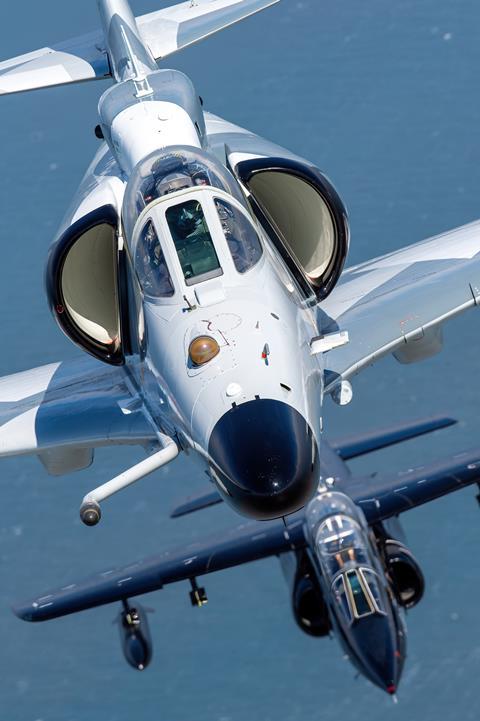Top Aces has delivered its first adversary air (ADAIR) training sorties for Canada using Douglas A-4 Skyhawks modified with equipment including an active electronically scanned array (AESA) radar.
Dubbed the A-4 Advanced Aggressor Fighter (AAF), the platform “can better replicate the advanced systems of a near-peer threat aircraft”, Top Aces says.

The company late last year signed an amended Contracted Airborne Training Services deal with the Royal Canadian Air Force (RCAF) to run through 2029. Its original contract had included the provision of upgraded Dassault/Dornier Alpha Jets and Bombardier Learjet 35s for ADAIR training.
“The first A-4 AAF mission took place with a formation of Alpha Jets, conducting air combat training in support of RCAF [Boeing] CF-18 pilots,” the company says.
GOOD LESSONS
Since 19 June, two A-4 AAFs have been in operational use in Canada, James ‘Preston’ Manning, vice-president Top Aces – Canada, tells FlightGlobal. So far, the new standard of jet “is delivering very good lessons for CF-18 pilots”, he adds.
“We now have a more capable threat platform to present to them,” he says, noting that the CF-18 fleet is currently undergoing its own AESA radar update.
Central to the company’s contracted service offering is its proprietary Advanced Aggressor Mission System (AAMS), which has so far been integrated with the A-4 and Lockheed Martin F-16. The open architecture system can support the use of other advanced technologies, such as an infrared search and track (IRST) sensor, tactical datalink, helmet-mounted cueing system and electronic attack (EA) functions.
“That drives a really powerful ability to evolve our offering as our customers’ requirements change,” Manning says. “We can offer a selection of mission capabilities to best meet our customers’ needs and budget.”
The company has developed a nose-mounted IRST installation for the A-4, and will use a pod-housed system on the F-16.
Since 2015, Top Aces has also delivered adversary training services to the German air force using the A-4 and Alpha Jet.
Meanwhile, Manning describes the Alpha Jet – a type which has been operated by the company for almost 20 years – as the workhorse of its adversary training fleet. “We have implemented a series of significant upgrades to it, but it remains a subsonic platform with reduced kinematic performance compared to the A-4 or F-16,” he says.

“I think the Alpha Jet has a place going forward, especially equipped with advanced EA pods, IRST, AAMS, and datalinks. It’s not going to be the frontline face of the adversary force, but can provide an increased quantity of targets that are being flown live. It can be offered at good value.”
At the top end of its offering, the company is supporting the US Air Force using F-16s. The sole commercial operator of the type, Top Aces has so far sourced just under 30 retired military examples.
“The F-16 provides the kinematic performance combined with a lower radar cross-section that better replicates the threats that our customers want to train against,” Manning says. “The baseline threat is networked advanced sensors, sharing information through a datalink.”
The company hopes to be able to expand its offering to additional nations using the Lockheed type, potentially before the end of this decade.
GENERATIONAL SHIFT
“We see very strong demand as air forces go from fourth- to fifth-generation fighters,” he says, with the RCAF preparing for future operations with an 88-strong fleet of Lockheed F-35As. “The addition of the [A-4] AAF in Canada will help mitigate some of the challenges on resource demand for the transition,” he adds.
For the longer term, “Our product development is already looking at what’s coming next: the implementation of AI [artificial intelligence], and potentially CCAs [collaborative combat aircraft],” he says. “We want to be able to provide the most relevant threat replication that’s available on the commercial market to meet customers’ training needs.”
Top Aces is also already exploring the potential future use of live, virtual and constructive technologies.
“We are waiting for the technology to mature, and our AAMS is ready to add that to our service offering as customers implement it,” he says.
Manning believes that the private adversary training sector “provides excellent value” to customers, by reducing wear and tear on frontline fleets which otherwise would be required to also support combat training in the ADAIR role. “Air forces are best served focusing on meeting their core requirements and readiness,” he says.
Meanwhile, he also points to the sector’s “importance in supporting the continued service of veterans”.
“This is an avenue where you can continue to have retired air force pilots in the briefs and debriefs, providing their valuable experience to mentor the next generation of combat leaders,” he says.
One of Top Aces’ European-based A-4s will be in the static display at the Royal International Air Tattoo at RAF Fairford in Gloucestershire, the UK from 19-21 July.


































